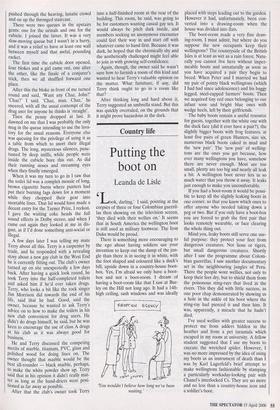Country life
Putting the boot on
Leanda de Lisle
Look, darling,' I said, pointing at the corpses of three or four Colombian guerril- las then showing on the television screen, 'they died with their wellies on.' It seems that in South America the wellington boot is still used as military footwear. The Iron Duke would be proud.
There is something more encouraging to the ego about having soldiers use your invention to keep out the damp of the jun- gle than there is in seeing it in white, with the foot shaped and coloured like a duck's bill, upside down in a country-house boot- box. Yes, I'm afraid we only have a boot- box and not a boot-room. I dream of having a boot-room like that I saw at Bur- ley on the Hill not long ago. It had a 14ft- high ceiling, sash windows and was ideally Thu wouldn't believe how long we ve been waiting.' placed with steps leading out to the garden. However it had, unfortunately, been con- verted into a drawing-room when the house was divided into flats.
The boot-room made a very fine draw- ing-room, I must admit, but where do you suppose the new occupants keep their wellingtons? The countryside of the British Isles is at least as wet as a rain forest. Natu- rally you cannot live here without imper- meable boots and unnaturally as soon as you have acquired a pair they begin to breed. When Peter and I married we had my pair of pointy black wellingtons (which I had had since adolescence) and his baggy legged, steel-capped farmers' boots. Then we acquired tiny red ones belonging to our infant sons and bright blue ones with wedge heels, left by their girlfriends.
The baby boots remain a useful resource for guests, together with the white one with the duck face (did it ever have a pair?), the slightly bigger boots with frog features, at least five pairs of green Hunters, size six, numerous black boots caked in mud and the 'new pair'. The 'new pair' of welling- tons are the ones you get because, how ever many wellingtons you have, somehow there are never enough. Most are too small, plenty are too big and nearly all leak a bit. A wellington boot never lets in so much water that you throw it away. It leaks just enough to make you uncomfortable.
If you had a boot-room it would be possi- ble to keep all the slightly leaking boots in one corner, so that you knew which ones to offer anyone who needed taking down a peg or two. But if you only have a boot-box you are forced to grab the first pair that looks remotely wearable, or face clearing the whole thing out.
Mind you, leaky boots still serve one use- ful purpose: they protect your feet from dangerous creatures. Not lions or tigers, but small dangerous creatures. Shortly after I saw the programme about Colom- bian guerrillas, I saw another documentary set in the neighbouring jungles of Peru. There the people wore wellies, not only to keep their feet dry, but to shield them from the poisonous sting-rays that lived in the rivers. This they did with little success, as one poor chap demonstrated by showing us a hole in the al-11de of his boot where the sting-ray had pierced it and then him. It was, apparently, a miracle that he hadn't died.
I've used wellies with greater success to protect me from adders hidden in the heather and from a pet tarantula which escaped in my room at university. A fellow student suggested that I use my boots to execute the wretched spider. However, I was no more impressed by the idea of using my boots as an instrument of death than I was by Karl Lagerfeld's brief attempt to make wellingtons fashionable by stamping a particularly workaday-looking pair with Chanel's interlocked Cs. They are no more and no less than a country-house icon and a soldier's boot.


































































 Previous page
Previous page